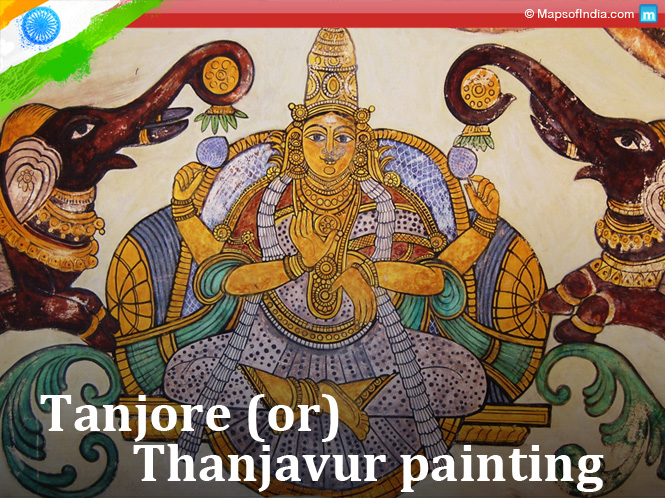Rich vibrant colors, pearls, semi-precious stones, and gold make the beautiful tanjore painting, an ancient art form of South India. Tanjore painting or thanjavur painting flourished in a place in southern India, known as Tanjavoor, and thus got its name. This ancient temple art style is traditional, but innovations are still done within certain limits. It is a temple art form as most of the paintings consist of images of Gods and Goddesses such as Lord Krishna, Shiva, Ganesha, Goddesses Paravati, Lakshmi etc.
Tanjore painting style originated at the time of Marathas in 16th and 17th century. The art form was greatly supported by the Nayakas Vijaynagar dynasty, Rajus communities of Tanjore and Trichi and Naidus of Madurai. Traditionally rubies, real diamonds and other precious stones were used to make Tanjore paintings.
Tanjore painting is available in three finishes:
Classic – Bright, striking colors and high-glitter gold foil are used.
Antique – Sober than the classic form in which subtle colors and less brighter glitter of gold are used.
Embossed – In color and look, it is similar to the classic style but with more depth.
You will be amazed to see the vibrant colors combined with glitter and gold. Adorn the walls of your home with Tanjore paintings!
How to make a Tanjore painting?
It is not that simple to create a Tanjore painting as the artist must follow many steps. Also, it is not a one-day job. To make sure that the final product is flawless, a lot of care must be taken at each step.
Material required: Plywood above 4 mm thickness, white cotton cloth, chalk power, adhesive, a flat brush (above 3″ width), sand paper (emery sheet), Arabic gum, coloured Jaipur stones, gold foil (pastel on paper), poster colors, rounded brushes (000, 0, 2, 4, 6,8), Multi-coloured transparent ink (photo color), cutter, ruler, red carbon paper, pencil, reference design to trace.
Procedure:
Prepare the canvas
First of all, a base is prepared by pasting a piece of cloth (white cotton lining) onto plywood (minimum 4mm thick). Cloth is pasted on the wood with the help of adhesive and water mixture. Make sure that no fold or bubble remains on the front side of the board. Let it dry.
Take the chalk powder. Mix it with water. Add adhesive to it and sieve the mixture. Take broad paint brush and evenly apply this mixture on the board in one direction. Let it dry. Apply another coat in opposite direction and again let it dry.
Make the surface smooth by rubbing with sand paper. You canvas is ready for the next step.
Design tracing
Trace the design by keeping red carbon paper on the board. Keep the design above the carbon paper and trace it. Make sure that the paper does not slip while tracing.
Sculptural step
To give an embossed look to the painting, apply muk (a mixture of chalk powder and Arabic gum in the ratio of 2:1) in the decorative areas. Let the canvas dry for a day. If more embossing is required, repeat the process.
Fix the stones with adhesive and water mixture on the embossed surface.
For better effect, apply the muk layer over beads. Let it dry for an hour. Once done, take white cotton cloth and dip its corner in water (squeeze the excess of water). Also put one drop of water on beads coated with the mixture. With cloth, gently wipe the mixture above the beads. Now the mixture will remain at the sides and not on the beads.
Improvised step
On the embossed area make a design with the help of an empty ball pen refill.
Take a cone and fill it with mixture of Arabic gum, chalk powder and adhesive in the ratio of 2:2:1/2. Fill the area of design, like a pillar, with the help of the cone.
Paste gold foil of very high quality on the area where required and very carefully remove over the stones. Cut the foil to expose the stones.
Coloring
Paint the figure and background with poster colors.
Framing
Get your Tanjore painting fixed either in plain wooden frame or the Chettinad type of frame that has an additional ornate design.
Handy Tips
- The outline of the image is generally brown or red, but for images of Krishna, it is blue.
- Mostly only one main figure is selected to create a Tanjore painting.
- Make the painting using bright and bold colors.




